Located in the south-east of Adelaide on the Kaurna peoples land of Tandayangga (place of the Red Kangaroo Dreaming), Hurtle Square was one of the six squares designed by Colonel William Light in his 1837 plan of Adelaide. The Square has since seen numerous planting schemes and re-designs that have altered both its appearance and layout.
Indigenous associations
Hurtle Square, due to its location in the east end of Adelaide, was not as popular as Light, Victoria and Whitmore Squares for Indigenous peoples who were mainly concentrated in the west end of Adelaide. However, it, like the other city squares, was used by Indigenous peoples as a place for social gatherings and as a meeting place.
Establishment and development of the Square
The city squares were designed by Colonel William Light, the appointed Surveyor-General of South Australia, in his 1836 plan of Adelaide. The plan included a total of six squares and a parklands area, encircling Adelaide with a ‘belt of greenery’.
Early in the nineteenth century these squares were largely left as they were before colonisation. This would soon change, however, as the City Corporation began to plan and gather funds for fencing and a mass planting scheme in 1854. The planting scheme detailed the species of trees to be planted and included acacia, almond, olive, gum, poplar and cypress trees. One thousand five hundred of these trees would be planted in Hurtle Square. Alongside these planting schemes, gravel paths were laid and a wooden split post and rail fence was constructed around the Square.
In 1874 a new planting scheme was proposed by City Gardener William O’Brien. He selected a series of ornamental trees to be planted in the city squares. The species of trees he selected included Norfolk Island pines, Moreton Bay figs, white cedars, Kurrajongs and cassia trees. While new trees were being added, the wooden fence surrounding the Square, which had begun to decay, was replaced by an ornamental cast iron palisade fence in 1881. The ornamental fence was part of the City Corporations’ beautification project. The Corporation invested £1,242 18s 6d alone into the fencing around Hurtle Square.
However, by the turn of the century the trees and gardens in Hurtle Square were deteriorating. A new City Gardener, August Wilhelm Pelzer, was appointed in 1899 to tidy up the Square. He set about this task by removing dead trees and those that were deemed ‘unsightly’. Couch grass lawns were also planted with metal hoops added in 1901 to protect the grass from people walking through it. These measures did not satisfy Mayor Lewis Cohen who labelled Hurtle Square the ‘dirtiest of all the Squares’ in 1902. He blamed the 69 Moreton Bay fig trees in the Square which continually shed leaves. Following this Pelzer set about removing trees, particularly the Moreton Bay figs, to allow more light through to the grass and to reduce the amount of leaves and figs that were being shed. Pelzer continued to beautify Hurtle Square, extending, planting and changing the shape of the flower beds from 1906 to 1907.
Along with all of the garden works, Hurtle Square was remodeled in 1909 to accommodate tram tracks. The Municipal Tramways Trust (MTT) paid a fair proportion of the costs for these works that were completed in 1910. Following the laying of the tracks, large areas of the Square were re-levelled, hedges added, grass relaid and a new palisade fence built. In 1924 further works were carried out. The cast iron palisade fence surrounding the Square was removed, the gravel paths were relaid with tar, seats added, lawn resown, trees removed, while new trees were planted. These works divided the Square into its current four quadrant arrangement and gave the landscape much of the shape that is seen today.
Sir James Hurtle Fisher
Hurtle Square was named by the Street Naming Committee after Sir James Hurtle Fisher, the first Resident Commisioner of South Australia. Fisher arrived in Glenelg with Governor Hindmarsh on the Buffalo in 1836 and served as the Resident Lands Commisioner until 1838. A couple of years later in 1840 he would begin his political career after being elected Mayor of Adelaide. During his political career, James Fisher would play a part in the introduction of responsible government in South Australia, advocating for its introduction in 1849. He would serve as the Chief Magistrate on four occasions and would also act as speaker of the Legislative Council and as president of the Upper House of Parliament. In social circles, Fisher was a founding member of the Adelaide Club and the president of the Adelaide Jockey Club. In 1860 he gained the honour of becoming the first South Australian resident to be knighted before retiring from politics in 1864. He died in 1875 and was buried in West Terrace Cemetery.
Recent History and additions to the Square
In recent years art installations and another name have been added to Hurtle Square.
Artist Steven Bowers installed a sculpture called Untitled in 1994. It was commissioned by the City Corporation as a memorial to John Bray who lived near Hurtle Square. It is located in the northwest corner of the Square and consists of a ceramic birdbath on top of a red brick cube base with mosaics on all four sides. The mosaics also include the following poem by Bray titled Address to the Pigeons in Hurtle Square:
The pigeons in the Square
Are pert and debonair.
Plumped out with scattered scraps
They cease to fear mishaps.
Accost me as I walk
With wheedling-salesman’s talk.
And when I don’t provide
They jostle me aside.
Security we know
Is mortals chiefest foe,
And Shakepeare’s warning words
Embrace both men and birds.
They end who this defy
Car’s lunch or pigeon pie.
So fly off, bludging crew,
And don’t shit on my shoe.
Another artistic installation titled The Forest of Dreams was made by Anton Hart in 2003. Located at the Pulteney and Halifax Street intersection that runs through Hurtle Square, the installation is constructed of steel and consists of the words ‘The Forest of Dreams’ with each word located on one of the four quadrants of the Square.
In March 2012 Hurtle Square was given the name Tangkaira as part of the Kaurna Naming Project. Tangkaira was the wife of Ityamaiitpinna, or King Rodney as he was known by the colonists, one of the three main Kaurna elders at the time of colonisation.


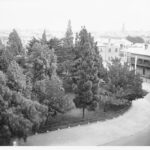

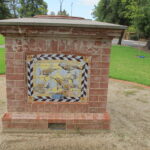
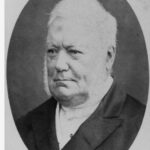

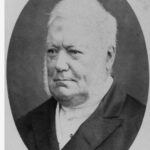
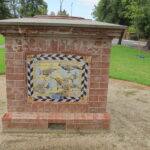
Comments